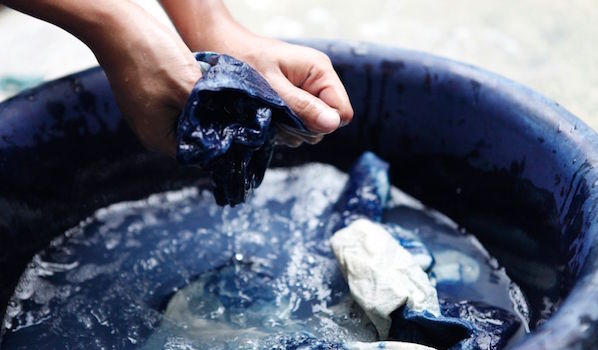
Cultivate, Dye, Create

Kerstin Neumüller and Douglas Luhanko met when Kerstin was looking for someone to dye indigo with and, by chance, stepped into Douglas’s shop on the very day he had ordered a kit for natural indigo dyeing. Since then, they have explored indigo’s possibilities and limitations together. Douglas manufactures jeans in his own company Blue Highway. Kerstin is a men’s tailor with her heart in handicrafts. Together they run the shop Second Sunrise in Stockholm.
Interview by Jessica Edney
How did you first become interested in indigo?
D: I have had a deep interest in jeans since I was a kid, and this has shaped my life as it is today. After me and my brother started to make our own jeans we went on a journey to Nevada together with some friends to see if we could find any old jeans left there by the miners during the gold rush, and after one of those journeys I felt like I had satisfied my need to know more about the history of jeans. Indigo, however, has a much longer and more diverse history and I felt really drawn to it as it also is closely connected to jeans!
K: Indigo is a dye that can be derived from plants, and I first learned about it during a plant dyeing course I was taking as a part of a year of studying folk costume sewing. It's the only dyestuff in nature that creates a colourfast blue, and it had a reputation of being really tricky to master so I was intrigued! I begged my teacher for the leftover dye vat from the course and spent that evening dyeing every piece of wool yarn I had, ending up with shades from murky purples via blue hues to brilliant greens. Ever since indigo holds a special place among natural dyes for me.

What do you think makes indigo particularly special?
First of all, indigo contains not only blue colour but also small amounts of red and green pigments, and we think that this is why the colour is so pleasing to the eye. Secondly, the pigment never becomes a part of the textile, but sticks to and in between the fibres. This is why the pigment also can be rubbed off when the garment is exposed to wear, and the effect of the fabric is stunning since it highlights the parts that are more worn, creating a sort of 3D effect.
Douglas, you specialise in denim. Why this material in particular?
Early on I was fascinated by the garments, materials and the counterculture connected to them. I didn't really enjoy history in school until I realized that the blue jeans me and my friends were wearing were a part of history and that the garments had so many stories to tell!

What is an average day like for you two?
We live together and we also run a clothing store, so we spend our days in the shop. There's no way of knowing who will step through the door and we have heard some amazing stories through the years and made many good friends. Sometimes people bring in things they think we might like such as diver's watches, items of vintage clothing or just some cookies for the afternoon coffee break. That's the best part of our job! We also have a lot going on apart from running the store and we host indigo workshops monthly, we're working on another book and we love to work with museums, participating in exhibitions and give lectures about indigo and denim.
Do you have a favourite dyeing technique?
Wax resist dyeing has become a favourite for us! We love how even if you use the same print block to create many repetitions of a pattern, it never comes out quite the same because as the temperature of the wax fluctuates it soaks into the fabric in variating degrees which in the end gives you a pattern that looks variated, yet repeated!

Do you have any advice for people who would like to get into dyeing with indigo but fear it might be too complicated?
Read some recipes to get your bearings in the world of dyeing and make sure you have plenty of time when you have your first go! Indigo dyeing is not brain surgery but it is a little more complicated than popping dye into your washing machine and pressing play. Getting everything in order can seem like a lot of work but it's all worth it when you get started with the actual dyeing!
Kerstin and Douglas are giving a talk on indigo at the Fashion and Textile Museum, London Thursday 2nd August, 6–8pm.
We are offering a free pair of tickets to the talk to one lucky winner.
Indigo: Cultivate, Dye Create by Kerstin Neumüller and Douglas Luhanko is published by Pavilion. Photographs by Fredrik Ottosson.
Buy your copy of Indigo (RRP £15.99) for only £12 including free UK P&P. Call 0844 576 8122 and quote offer code CH2022. www.pavilionbooks.com

